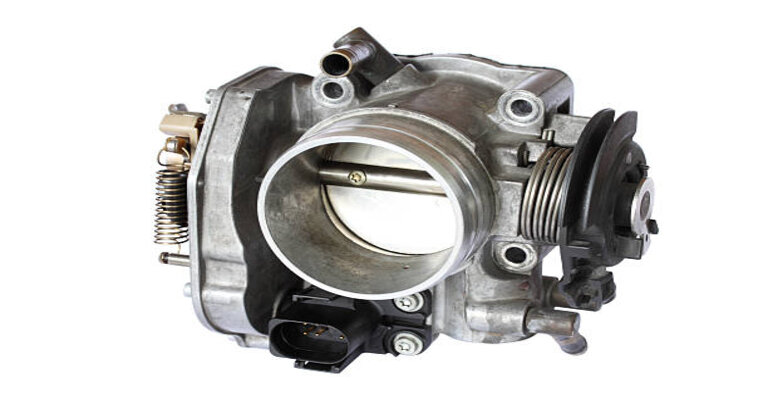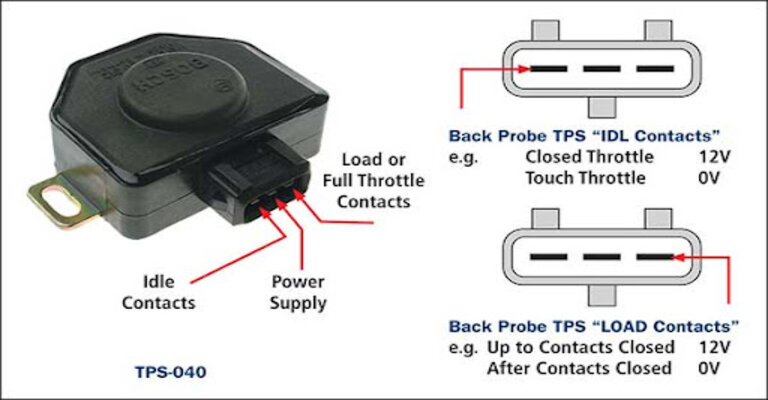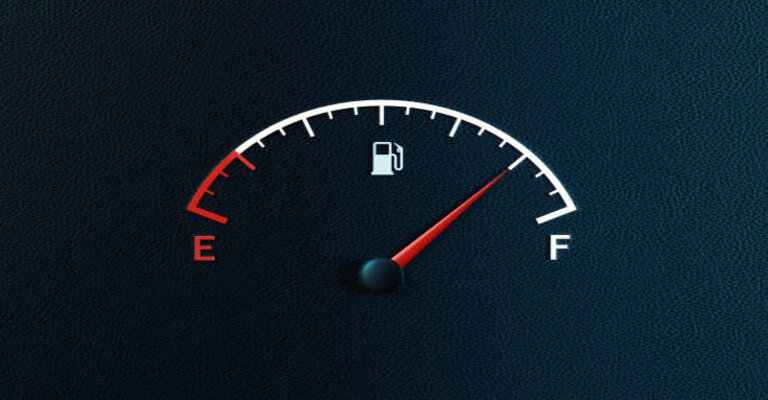
The older generation of cars had mechanical engine components that did not rely on electronics to work. Simple carburettors and throttle valves operated by springs and cables worked without any digital gadgetry. But modern cars are driven by an ECU, a sophisticated computer that electronically controls major components of the vehicle. The throttle position sensor is part of a fuel-injected engine system that measures the position of the throttle and intake components. Based on this data, the right amount of air and fuel is administered to the combustion chamber for the smooth running of the engine.

This article discusses some of the symptoms of a bad throttle position sensor, and what you can do to solve them.
Also Checkout Fuel Injection Vs Carburetor: Which Is the Best?
What is a throttle position sensor or TPS?
The throttle position sensor’s primary concern is to determine the throttle valve angle and how far the accelerator pedal is pressed. These readings are sent to the engine control module which sends signals to the fuel injectors and the intake valve to administer the correct air-fuel mixture to the engine. Other sensors work in conjunction with the fuel system, such as the exhaust gas temperature sensor, oxygen sensor, and engine speed sensor (to measure engine rpm).
Checkout article: Teflon coating vs ceramic coating

What are the major symptoms of a failing throttle position sensor?
You need to be aware of signs that the throttle position sensor in your engine is malfunctioning. Here are some engine and driving issues you need to pay attention to.
Erratic idling
When there is no throttle input, the engine should idle smoothly at a constant rpm. The throttle position sensor tells the ECU that there is no accelerator input and that the amount of fuel entering the engine should remain constant. If the rpms suddenly rise and then fall again without touching the accelerator pedal, it could be a symptom of a faulty throttle position sensor.
Also read: Everything about brake boosters
Check engine warning light
Since all engine sensors are connected to the ECU electronically, any fault in the system will show up as a check engine warning indicator on the instrument cluster. Usually, once the throttle position sensor is replaced and the system has been reset, the warning light disappears.

Poor Engine Performance
A step on the accelerator pedal should signal the fuel system to inject more petrol into the cylinders. A faulty throttle position sensor will not respond to pedal input and you will not receive adequate power when required.
Increased Fuel Consumption
Incorrect signals to the fuel injectors may cause them to dump fuel in the combustion chamber which leads to poor fuel economy.

Some other common symptoms of a bad throttle input sensor include jerking while driving, engine rpm rising with no throttle input or falling inexplicably. The engine may fail to start after being parked for a while or may stall in the middle of the road. Basically, the engine is not going to feel smooth at all and you will struggle to accelerate when needed.
Also, check out: Types of fuel used in cars in India
Conclusion
A throttle position sensor is inexpensive to replace at around Rs.1500 for most passenger cars. If you notice any of the symptoms mentioned in this article, then you should have your vehicle checked out by a certified mechanic as soon as possible. The repair is definitely worth it because if left unattended, there could be more severe problems like other sensors failing or catastrophic engine damage in the long run.
If you found this article on symptoms of a bad throttle position sensor informative and interesting, perhaps you should check out Fuel Mileage Dropping Without Any Reason? and How to connect your smartphone to the car via Bluetooth or you can visit Carorbis Blog.
Frequently Asked Questions
Q1. How to Fix Throttle Position Sensor?
Ans. First, disconnect the negative battery terminal so that you don’t receive and electric shock while working on the engine. This will also keep the ECU offline. Wait five minutes for a throttle position sensor reset. You can also remove the ECU fuse for 5 minutes to reset the sensors. The TPS (Throttle Position Sensor) should start working properly once you reconnect the fuse and battery terminal. This method is used to reset the error codes that caused the sensors to malfunction.
Q2. Can a Bad Throttle Body Cause Transmission Problem?
Ans. For cars with automatic transmissions, there are various sensors that dictate when gears are changed during driving. The throttle body position sensor tells the ECU when the accelerator is used and regulates the amount of air and fuel supplied to the engine. The throttle position sensor also tells the transmission when it is time to change gears (for example, if the accelerator is fully pressed, the transmission kicks down a gear for better acceleration). A faulty throttle position sensor can cause problems with the transmission.
Q3. What Happens When Throttle Position Sensor Goes Bad?
Ans. The throttle position sensor governs the throttle body that allows air to flow into the engine. When the TPS goes bad, the throttle body may not open and the engine will not be able to run without air. It may cause erratic idling, stalling, and sudden surges of acceleration. The car may not start when the TPS is faulty. You should see a check engine warning light on your dashboard telling you that there is a problem that needs to be addressed.
Q4. Can a Bad Throttle Position Sensor Cause Misfire?
Ans. When the throttle position sensor is faulty, there will be inadequate an air-fuel mixture sent to the combustion chamber. This may cause unstable engine performance because there is not enough power produced. Idling will fluctuate as engine rpms rise and fall without movement of the throttle. With an insufficient amount of air in the fuel mixture, misfiring is very likely to occur. There may be incomplete combustion, firing at the wrong time or unburnt gases moving into the exhaust manifold.
Q5. How Long Can You Drive With a Bad Throttle Position Sensor?
Ans. It is not safe to drive with a bad throttle position sensor because the car may accelerate on its own without any input. This can cause an accident and serious injury to the driver, passengers or other motorists. If you suspect you have a bad throttle position sensor, drive to the nearest repair shop as soon as possible, or better still, get a mechanic to check out your car wherever it is parked. You may also risk damaging other sensitive engine components if you drive with a faulty TPS.
Q6. How Do You Test a Throttle Position Sensor?
Ans. Clean the throttle body of any debris that may be causing it to malfunction. Set a multimeter to a 10-volt DC range. Place the negative black probe of the multimeter on the ground terminal of the throttle position sensor. Now place the positive red probe of the multimeter on the reference terminal of the TPS. You should get a multimeter reading of 5 volts or more. If you have a reading of fewer than 5 volts, you know the TPS is bad and needs to be replaced.
Q7. Can You Clean Throttle Position Sensor?
Ans. Disconnect the throttle sensor and throttle body from the intake system. Use a cleaning solvent and clean cloth to remove any grime or carbon deposits around the TPS unit and assembly. The TPS sensor is an electrical component and should not be cleaned with the solvent. Once this process is done, reconnect the throttle body and TPS sensor and check that the engine is running smoothly. Throttle position sensors and throttle bodies needed to be cleaned every 50,000 km at the time of service. This ensures that the engine will function properly and components will last longer.
Q8. How Much is a TPS Sensor?
Ans. The price of a TPS sensor depends on the make and model of the car it belongs to. For small passenger cars and SUVs, a TPS sensor will cost in the range of Rs.1000 -2000. The TPS is placed in a convenient location on the throttle body so that it can easily be replaced. You just need to disconnect the electrical connections, undo the screws and remove the sensor from its housing. TPS are widely available online and at offline car accessory and spare parts stores.
Q9. What Causes Throttle Position Sensor Failure?
Ans. The TPS (throttle position sensor) is a potentiometer that measures the throttle valve angle in terms of electrical conductivity in the circuit. If there is some loose contact in the electrical wiring, the throttle position sensor will provide an inaccurate reading to the ECU which may cause sudden acceleration or erratic idling of the engine. The TPS sensor can send signals to the ECU to adjust the amount of fuel injected into the cylinders and the quantity of air from the intake valve.
Q10. Can You Replace Just the Throttle Position Sensor?
Ans. You can replace the throttle position sensor and check if the engine is responding to the new part. If the problem of erratic idling, uneven acceleration and poor fuel consumption continues after replacing the throttle position sensor, then it is likely that there is a problem with the intake system or throttle body. Have all the systems checked out thoroughly. A diagnostic scan of the ECU will usually identify which part of the engine you need to pay attention to. A new throttle position sensor needs to be calibrated before the engine is run. This can be done via ECU settings.
Q11. How Do You Fix a Throttle Position Sensor?
Ans. Throttle position sensors can be reset by disconnecting the battery terminals for at least 5 minutes. You can even pull out the ECU fuse to reset the sensors. If this doesn’t help with the engine problem, then it is best to replace the TPS with a new one. Check of the engine performance is back to normal with a new throttle position sensor. A faulty sensor will cause the engine to respond unpredictably. You will have sudden acceleration or sometimes no throttle response. Expect to have poor fuel economy as a result of a faulty TPS. Inadequate air supply to the engine may cause the cylinders to misfire or put more strain on engine components during hard acceleration. There may be unburnt gases in the exhaust system which could damage the exhaust catalytic converter.
Q12. What Are the Symptoms of a Dirty Throttle Body?
Ans. Some symptoms of a dirty throttle body include jerking of the vehicle due to the engine not receiving enough fuel and air. Idling may not be constant with sudden surges in engine rpm. The car may stall while driving and hesitate uphill or even on level ground. Cruise control may cease to function and you should have a warning light on your instrument cluster to check the engine. If your car is equipped with an automatic transmission, you may have trouble when shifting gears as the ECU will be sending incorrect data to the gearbox actuators. Lastly, the fuel economy may drop as the engine consumes more petrol or diesel while running.
Q13. Can a Throttle Position Sensor Cause Reduced Engine Power?
Ans. Yes, when the throttle position sensor is faulty, it will send inaccurate readings to the ECU which will prevent the throttle valves from opening correctly. This will alter the amount of intake air and the quantity of fuel entering the combustion chamber. As a result, the engine will produce less power or may refuse to accelerate on demand. There will also be an increase in fuel consumption to compensate for this power loss.
Q14. Can Throttle Position Sensor Affect Transmission Shifting?
Ans. An automatic transmission looks for data from the throttle position sensor to shift gears at the right time (such as when the driver steps on the accelerator pedal). If the TPS is faulty, the transmission system may change gears at the wrong time or there may be a delayed response from the gearbox. This will affect the engine performance during acceleration or when climbing uphill. The throttle position sensor is used to determine the load on the engine. The transmission is dependent on the throttle position for the optimum working of the gearbox.








